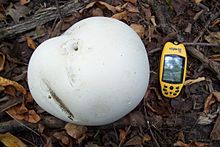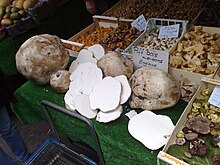| Giant puffball | |
|---|---|

| |
| Giant puffball with a 11.7 x 5.4 cm GPS receiver for scale | |
| Scientific classification | |
| Domain: | Eukaryota |
| Kingdom: | Fungi |
| Division: | Basidiomycota |
| Class: | Agaricomycetes |
| Order: | Agaricales |
| Family: | Agaricaceae |
| Genus: | Calvatia |
| Species: | C. gigantea |
| Binomial name | |
| Calvatia gigantea (Batsch ex Pers.) Lloyd | |
| Synonyms | |
|
Langermannia gigantea | |
| Calvatia gigantea | |
|---|---|
| Glebal hymenium | |
| No distinct cap | |
| Hymenium attachment is not applicable | |
| Lacks a stipe | |
| Spore print is brown | |
| Ecology is saprotrophic | |
| Edibility is choice or inedible | |
Calvatia gigantea, commonly known in English as the giant puffball, is a puffball mushroom commonly found in meadows, fields, and deciduous forests in late summer and autumn. It is found in temperate areas throughout the world.
Description
According to the Missouri Department of Conservation, Calvatia gigantea typically grows up to 20–50 centimetres (8–19+1⁄2 in) wide and high. According to First Nature, it "can grow to 80 cm diameter and weigh several kilograms". A specimen weighing over 23 kg (51 lb) was recorded in Thunder Bay, Ontario, Canada.
The interior of an immature puffball is white, while that of a mature specimen is greenish brown. The fruiting body of a puffball mushroom develops within a few weeks and soon begins to decompose and rot (at which point it is dangerous to eat). Unlike most mushrooms, all the spores of the giant puffball are created inside the fruiting body; large specimens can easily contain several trillion. The spores are yellowish, smooth, and 3–5 μm in size.
Similar fungi
Giant puffballs resemble the poisonous earthball (Scleroderma citrinum). The latter are distinguished by a much firmer, elastic fruiting body, and having an interior that becomes dark purplish-black with white reticulation early in development.
Taxonomy
The classification of this species has been revised in recent years. First Nature explains that "puffballs, earthballs, earthstars, stinkhorns and several other kinds of fungi were once thought to be related and were known as the gasteromycetes or 'stomach' fungi, because the fertile material develops inside spherical or pear-shaped fruitbodies." However, many mycologists now believe that "the gasteromycetes" do not share single ancestor; they are polyphyletic.
Today, some authors place the giant puffball and other members of genus Calvatia in order Agaricales. The giant puffball has also been placed in two other genera, Lycoperdon and Langermannia, in years past. The current view is that the giant puffball is Calvatia.
Conservation status
The giant puffball is widespread and common in the United Kingdom. It is protected in parts of Poland and is of conservation concern in Norway.
Uses

Cooking
The large white mushrooms are edible when young, as are all true puffballs, but they can cause digestive issues if the spores have begun to form—as indicated by the color of the flesh being yellowish or greenish-brown instead of pure white. The Lovesick Lake Native Women's Association explains that an overripe puffball "will fall apart when touched or if cut open" and should be discarded.
Immature gilled species still contained within their universal veil can be lookalikes for puffballs. Many such species are poisonous or even deadly. To distinguish puffballs from such poisonous fungi, they must be cut open; edible puffballs will have a solid white interior and have "no gills or other imperfections".
Medical
Puffballs are a known styptic and have long been used as wound dressing, either in powdered form or as slices 3 cm thick. Authors Hui-Yeng Y. Yap, Mohammad Farhan Ariffeen Rosli, et al. found evidence to suggest that C. gigantea was "traditionally used by American Indians, Nigerian and German folks" for this purpose. The authors, however, did not specify the preferred form of wound dressing (e.g., powdered or sliced).
New Zealand Māori used it to stem bleeding and treat burns, it was also a food source.
References
- ^ "Calvatia gigantea (giant puffball)", Discover plants and fungi, www.kew.org, archived from the original on 2016-12-22, retrieved 8 August 2015
- "Giant Puffball". Missouri Department of Conservation. Retrieved 2023-12-01.
- "Calvatia gigantea, Giant Puffball, identification". first-nature.com. Retrieved 2023-12-01.
- Star, Signe Langford Special to the (2020-09-20). "It's Giant Puffball mushroom season. Here's how to identify and prepare them". Toronto Star. Retrieved 2023-12-01.
- ^ Arora, David (1986). Mushrooms Demystified. Berkeley, California: Ten Speed Press. pp. 158–159. ISBN 978-0-89815-169-5.
- ^ Bessette, Alan E. (1997). Mushrooms of Northeastern North America. Syracuse, NY: Syracuse University Press. pp. 453–454. ISBN 978-0-8156-0388-7.
- "Calvatia gigantea, Giant Puffball, identification". first-nature.com. Retrieved 2023-12-01.
- Volk, First. "Tom Volk's Fungus of the Month for August 1998". Retrieved 6 October 2012.
- Lovesick Lake Native Women's Association (1985). The Rural and Native Heritage Cookbook (1 ed.). Burleigh Falls, Ontario: Paul-Printing (Community Publication). p. 101. ISBN 0-9692-255-0-4.
- Meuninck, Jim (2017). Foraging Mushrooms Oregon: Finding, Identifying, and Preparing Edible Wild Mushrooms. Falcon Guides. p. 38. ISBN 978-1-4930-2669-2.
- Star, Signe Langford Special to the (2020-09-20). "It's Giant Puffball mushroom season. Here's how to identify and prepare them". Toronto Star. Retrieved 2023-12-01.
- Davies, Barry (2001). SAS mountain and arctic survival. London: Virgin. p. 87. ISBN 9780753505991.
- Yap, Hui-Yeng Y.; Ariffeen Rosli, Mohammad Farhan; Tan, Soon-Hao; Kong, Boon-Hong; Fung, Shin-Yee (2023). "The Wound Healing Potential of Lignosus rhinocerus and Other Ethno-myco Wound Healing Agents". Mycobiology. 51 (1): 1–15. doi:10.1080/12298093.2022.2164641. ISSN 1229-8093. PMC 9946334. PMID 36846625.
- Sisson, Liv; Vigus, Paula (2023). Fungi of Aotearoa: a curious forager's field guide. Auckland, New Zealand: Penguin Books. pp. 116–117. ISBN 978-1-76104-787-9. OCLC 1372569849.
Further reading
- Zhu, Wenyou; Guo, Chunxia; Luo, Fan (January 2015). "Optimization of Calvatia gigantea myceliaproduction from distillery wastewater". Journal of the Institute of Brewing. 121 (1): 78–86. doi:10.1002/jib.200.
- Kivrak, Ibrahim; Kivrak, Seyda; Harmandar, Mansur (1 September 2014). "Free amino acid profiling in the giant puffball mushroom (Calvatia gigantea) using UPLC-MS/MS". Food Chemistry. 158: 88–92. doi:10.1016/j.foodchem.2014.02.108. PMID 24731318.
- Coetzee, Johannes C.; Van Wyk, Abraham E. (January 2013). "Nomenclatural and taxonomic notes on Calvatia (Lycoperdaceae) and associated genera". Mycotaxon. 121 (1): 29–36. doi:10.5248/121.29. hdl:2263/21213.
External links
- Video footage of mature Giant Puffballs
- The Giant Puffball
- VOLATILES OF THE GIANT PUFFBALL MUSHROOM (Calvatia gigantea)
| Taxon identifiers | |
|---|---|
| Calvatia gigantea |
|
| Lycoperdon giganteum | |



